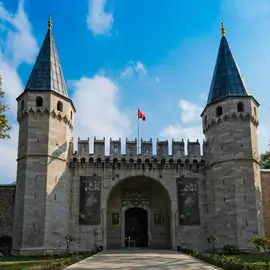Few places capture the spirit of Istanbul like Topkapi Palace. Perched on a hill overlooking the Bosphorus, Golden Horn, and Sea of Marmara, this sprawling complex was once the center of Ottoman power. For nearly 400 years, it housed sultans, queens, and courtiers, serving as both a royal residence and the empire’s administrative hub. Today, it’s one of Istanbul’s most fascinating museums, offering visitors a chance to step directly into history.
A Palace Born of Conquest
Topkapi Palace was commissioned by Sultan Mehmed II (Mehmed the Conqueror) shortly after his conquest of Constantinople in 1453. Completed in the late 15th century, it became the seat of Ottoman rule. Over time, the palace grew into a vast complex of courtyards, gardens, and chambers, each reflecting the grandeur and influence of one of the world’s greatest empires.
Exploring the Palace
The palace is divided into four main courtyards, each leading deeper into the world of the Ottoman elite. Walking through them feels like moving through layers of history.
First Courtyard – The Outer World
This was the public space, accessible to anyone. Known as the “Court of the Janissaries,” it once hosted imperial ceremonies and included gardens, a hospital, and kitchens that prepared meals for thousands daily.
Second Courtyard – Power and Administration
Here you’ll find the Imperial Council Chamber, where grand viziers met to discuss state affairs. Nearby, the kitchens now display collections of fine porcelain, once imported from China and Japan, showing the empire’s global reach.
Third Courtyard – The Sultan’s Private Realm
Access to this courtyard was highly restricted. Here stands the Audience Chamber, where sultans received ambassadors. The courtyard also houses the Imperial Treasury, with displays of jeweled thrones, emeralds, diamonds, and the legendary Topkapi Dagger.
The Harem – The Palace Within the Palace
The Harem is perhaps the most intriguing part of Topkapi. Once the private living quarters of the sultan, his family, and concubines, it’s a maze of ornately decorated rooms, tiled corridors, and lavish courtyards. This was where political intrigue, family drama, and royal upbringing unfolded behind closed doors.
Fourth Courtyard – Gardens and Views
The final courtyard offers terraces and gardens with sweeping views of the Bosphorus. It was a space of relaxation for the sultans, complete with pavilions and fountains.
Highlights Not to Miss
- The Imperial Treasury – Home to the Spoonmaker’s Diamond, an 86-carat gem, and other priceless artifacts.
- The Prophet’s Relics – A collection of sacred Islamic relics, including swords, cloaks, and letters attributed to the Prophet Muhammad and his companions.
- Iznik Tiles – Found throughout the Harem, these beautifully patterned tiles showcase Ottoman artistry.
- The Views – From the palace terraces, you’ll see Istanbul’s skyline in all its glory.
Visiting Tips
- Plan Enough Time: The palace is huge—set aside at least 3–4 hours.
- Tickets: The Harem requires a separate ticket, but it’s absolutely worth it.
- Best Time to Visit: Early morning to avoid crowds, especially during peak tourist season.
- Dress Comfortably: There’s a lot of walking, so wear good shoes.
Why Topkapi Palace Matters
Topkapi Palace isn’t just an architectural marvel; it’s a living history book. Within its walls, you see how sultans ruled, how empires were managed, and how cultures blended. It reflects the Ottoman Empire’s might, but also its love of art, beauty, and ceremony.
Final Thoughts
A visit to Istanbul wouldn’t be complete without stepping into Topkapi Palace. Whether you’re marveling at glittering jewels, wandering through tiled chambers of the Harem, or simply gazing out over the Bosphorus, the palace connects you to centuries of history. It’s more than a museum—it’s the beating heart of the Ottoman legacy.
